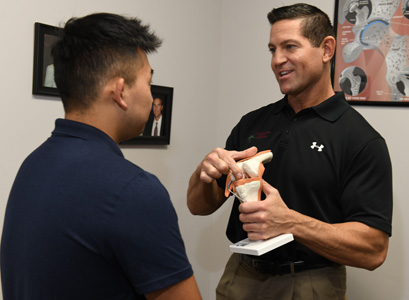Chondromalacia Patella
 Chondromalacia Patella
Chondromalacia Patella
 Runners, jumpers, and other athletes such as skiers, cyclists, and soccer players put heavy stress on their knees. Runner’s knee is a term used to refer to a number of medical conditions that cause pain around the front of the knee, or patellofemoral pain. These conditions include anterior knee pain syndrome, patellofemoral malalignment, and chondromalacia patella.
Runners, jumpers, and other athletes such as skiers, cyclists, and soccer players put heavy stress on their knees. Runner’s knee is a term used to refer to a number of medical conditions that cause pain around the front of the knee, or patellofemoral pain. These conditions include anterior knee pain syndrome, patellofemoral malalignment, and chondromalacia patella.
Symptoms
A dull, aching pain under or around the front of the kneecap (patella) where it connects with the lower end of the thighbone (femur) is the most common symptom. The pain can occur when walking up or down stairs, kneeling, squatting, and sitting with a bent knee for a long period of time.
Causes
A number of factors can contribute to runner’s knee, including:
- Malalignment of the kneecap
- Complete or partial dislocation
- Injury
- Excessive training or overuse
- Tightness, imbalance, or weakness of thigh muscles
- Flat feet
Patellofemoral pain may be the result of irritation of the soft tissues around the front of the knee. Other contributing factors include overuse, muscle imbalance and inadequate stretching. Pain that begins in another part of the body, such as the back or hip, may also cause pain in the knee.
If the kneecap is out of alignment, vigorous activities can cause excessive stress and wear on the cartilage of the kneecap. This can lead to softening and breakdown of the cartilage on the patella (chondromalacia patella) and cause pain in the underlying bone and irritation of the joint lining.
Treatment Options
Treatment depends on the particular problem causing the knee pain and is usually nonsurgical. Stop doing any activities that cause pain in the knee. Do not start again until you can do them without any pain. This probably means stopping any running or jumping.
Use the RICE formula:
-
Rest: Avoid putting weight on the painful knee.
-
Ice: Apply cold packs or ice wrapped in a towel for short periods of time, several times a day.
-
Compression: Use an elastic bandage, such as a simple knee sleeve with the kneecap cut out, that fits snugly without causing pain.
-
Elevation: Keep the knee raised higher than your heart.
Take nonsteroidal anti-inflammatory medications such as aspirin or ibuprofen if you need more pain relief. Runner’s knee usually gets better with early treatment and reconditioning.
Other nonsurgical treatments involve taping the kneecap or using a special brace for knee support during sports participation. Special shoe inserts (orthotics) may sometimes be prescribed and may help relieve the pain.
When needed, surgical treatments include:
-
Arthroscopy. Your Celebration Orthopaedics orthopaedic surgeon will remove fragments of damaged kneecap cartilage through a small incision, using a pencil-sized instrument called an arthroscope.
-
Realignment. Your surgeon opens the knee structure and realigns the kneecap, reducing the abnormal pressure on cartilage and supporting structures around the front of the knee.
Recovery
There’s no easy answer to when your knee will feel better. People heal at different rates. Recovery time depends on your particular case. While you get better, try out a new activity that won't aggravate your runner’s knee. Physical therapy may be a role in your recovery program. Your Celebration Orthopaedics orthopedic surgeon and physical therapist will design a program, often involving alternative exercises such as cycling or swimming, to strengthen your knee.
Whatever you do, do not rush the process. Don’t return to your old level of physical activity until:
-
You feel no pain in your knee when you bend or straighten it.
-
You feel no pain in your knee when you walk, jog, sprint, or jump.
-
Your knee feels as strong as your uninjured knee.

 Knee
Knee